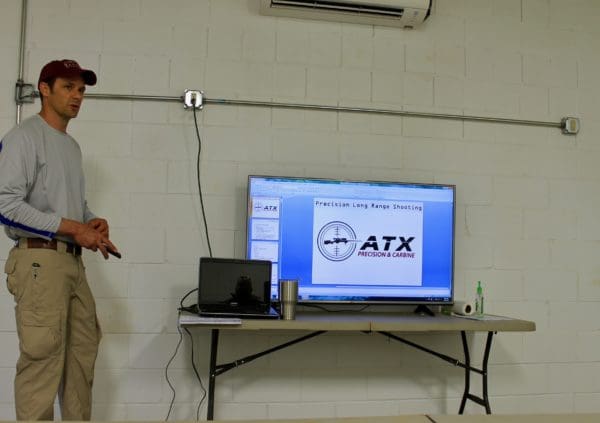
Seemingly overnight, I lost my enthusiasm for most of the new rifles and pistols coming my way for review. Oh sure, an odd straight pull rifle, or a specific handgun might pique my interest, but broadly speaking, I don’t yearn for much these days. A major contributing factor in that was what I saw as a plateau in my abilities as a shooter.
Despite thousands of rounds fired, I’m only incrementally better as a shooter than I was two years ago. Naturally, I set out to find a quality trainer, but was somewhat stymied. The classes I wanted to take were either too far away, required too much time off from work, or were prohibitively expensive. Then I met Clayton Hergert, the lead instructor and owner of ATX Precision.
Clayton helped run the SWAT Competition at last year’s Texas Gun Fest and was kind enough to spend a couple minutes chatting with me at the event. At the time, he was just launching his training business so I asked to be put on his “interested parties” mailing list. At the beginning of the year, I got a note that he was opening up dates for a Civilian Precision Rifle class to be hosted at Reveille Peak Ranch one hour northwest of Austin, TX.
The class is two days long on a Saturday/Sunday and costs $625 per person. If you sign up with a buddy, the discounted rate is $550. I took advantage of the discount and found a couple buddies, including TTAG’s resident Oregonian, Tom in Oregon.
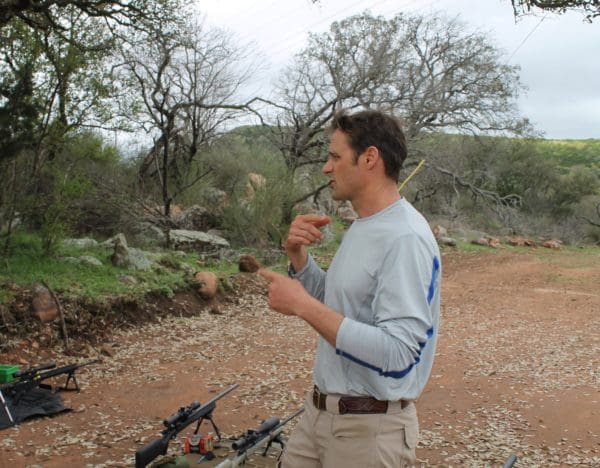
As the class size is small, the format is built from scratch, and still relatively new, Clayton is happy to tailor the direction of the class to meet the needs of all the students. Our class was comprised of five people. Two were shooting .308s – one gas, one bolt, two were shooting bolt action 6.5 Creedmoors, and one was a clownshoe blogger who brought two bolt action rifles, one in .308 and another in 6.5 Creedmoor.
Prior to class, Clayton emailed the group to ask what our goals for class were. Below were my big three items:
1.) proper body position, trigger control, breathing, etc. I’m self taught and I know for a fact I have some bad habits, but I don’t know what they are. So I’d like to have a neutral third party evaluate my shot setup from prone, and various other supported positions.
1a.) it sounds like this will be covered, but setting up stable shooting positions from various uncomfortable or improvised field positions. i.e – tall grass, rocks, barricades, vehicles, etc.
2.) Wind calling/Shot calling – I’m hoping that this comes out naturally from our shooting/spotting activities, but one of the biggest limitations I’ve found in my shooting practice is the ability to read the wind and incorporate it into my shooting app of choice. I would also like any input on being a better spotter, especially spotting misses and effectively communicating that to my shooter.
In addition to that, my buddy Jacob added in that he wanted to do a much better job of collecting data. He’d tried various haphazard approaches in the past and wanted to hear from a shooting professional what the most effective logbook format looked like.

A note on that shooting professional thing. There’s a tired joke about how to find out if someone is/was a Navy SEAL/vegan/crossfitter – just wait – they’ll tell you. Unfortunately, Clayton proved to be the exception to the joke. He’s an incredibly humble guy. In fact, the only way that I know that he’s a retired SEAL with an extensive background in firearms instruction is because he posts a short bio on his website. During two days of class, he made multiple references to his time in the service, but only as a reference point for a thing he’d learned.
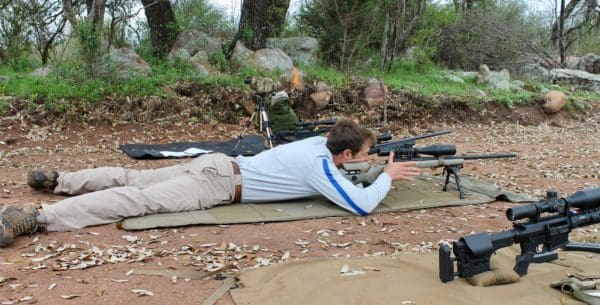
Day 1
As I stare out the window at perfectly sunny, clear day while I compose this, I can’t help but laugh that the only truly miserable weather I’d seen in weeks happened the two days that I’d be outside the whole time. The first day started overcast in the mid 60’s and stayed that way through lunch time when the skies opened up and got our class thoroughly soaked. 
At the beginning of the morning session, Clayton gave us a quick intro and overview, gathered our lunch orders and then walked us around the corner to the covered 100 yard range off the back steps of the classroom building. This is easily one of the nicest features of the Reveille Peak Ranch facility. You can do thirty minutes of instruction in a climate controlled, surgically lit room and then take ten steps and be on a covered 100 yard range to apply some of the skills you just acquired. We used the facility to establish a zero at 100 yards, and then quickly moved over to the 700 yard “Powerline” range about 200 yards away from the classroom.

Here, we were able to space ourselves out enough so that everyone could lay out prone and shoot at targets from 300 yards out to 700. We used this time to work on form, positioning behind the rifle, recoil management, and to get accurate D.O.P.E for our rifles. As I was shooting Bergara’s brand new HMR, and had less than 20 rounds down the tube before the start of class, I was very happy to get data out to that range with and without a Dead Air Sandman S screwed to the end.
I found that at longer ranges, the data from my Kestrel was significantly different than what I was seeing downrange. Not surprising as I’d had very little time to get this rifle ready for class. This ended up being something that Clayton and I would discuss further later in the weekend. With impending rain coming, we retired to the primary classroom to debrief, eat a catered lunch, and discuss a wind problem.
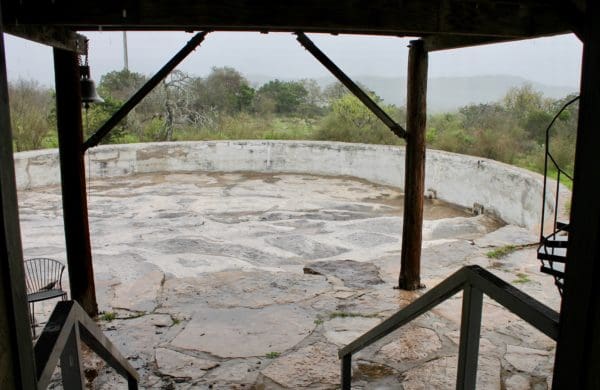
After discussing the long hand calculation for a wind problem, and a bit more on rifle fit, we headed over to the secondary classroom – a double wide manufactured home with the biggest swimming pool I’ve ever seen. As RPR is a former graphite mine, there are several locations around the ranch from that operation including this water catch tank.

Inside the classroom, Clayton worked with one of the students to help him fit his recently acquired Savage Model 10 for proper eye relief and body positioning. As the student was every bit of six feet tall, the factory length of pull was a tad short, and the comb height was a bit low.
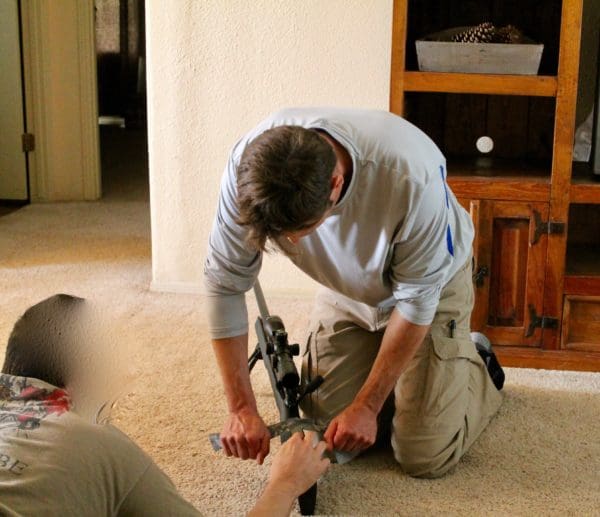
Luckily, Clayton had piles of stiff foam, and rolls of duct tape, so he was able to easily put together a durable cheek riser in only a few minutes. He suggested that the student pick up a recoil pad at some point to help with length of pull. The next morning, the student arrived with this.
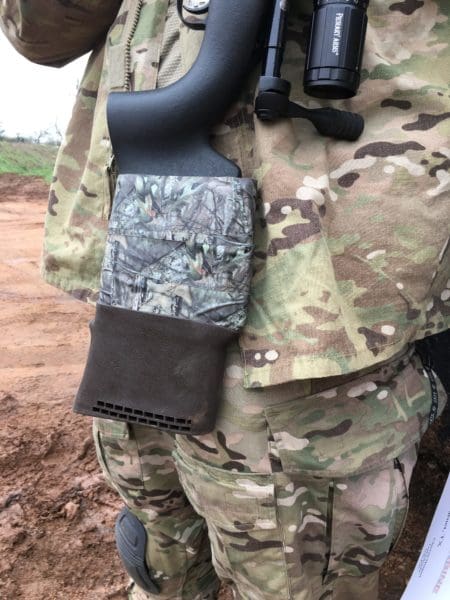
After getting some rifle fit out of the way, we went to the “flat” range a few miles away that includes a six inch steel mover and several hanging gongs. What’s especially nice about this range is that it is perfectly level out to ~820 yards which allows for another opportunity to establish good rifle D.O.P.E. We also had a bit more room to spread out and work on movers until the controller unit for that target died. Once that happened, we just moved further back 100 yards at a time to the 800 yard line.

Above is a photo that Clayton took of my form while I was engaging the mover. Easily one of the most helpful things Clayton did for me, and other students, was to take a few pictures of our form while we were shooting. In my case, I have a fairly pronounced C-shape to my spine as I try to get situated behind the rifle.
Clayton worked with me a bit on my rifle fit on the range and we found that removing a spacer from the stock of the Bergara HMR helped quite a bit with this. Several days later, I got a text from Clayton where he explained that I might want to consider readjusting my optic a bit on that rifle given that I had adjusted length of pull. I’d already pulled the optic for another rifle by that time, but the gesture was appreciated.
After the first day wrapped up, our group joined Clayton and students from a different class for burgers, beers, and conversation at the pavilion onsite at Reveille Peak Ranch. I don’t think we accomplished much in the way of becoming better rifleman that evening, but we did enjoy some good food and conversation. 
Day 2
The second day started with a quick 100 yard zero to ensure that we were back on target, and that nothing major had shifted. I was pleased to see that both of my rifles were doing what they’d done the day before. I elected to run silencers on both for the duration of day two, so I adjusted my zero to compensate and then we hit the flat range.

At the flat range, we spent a lot more focused time working the (now operational) mover, and working on a variety of non prone positions. Clayton was kind enough to bring out some tripod heads he’d put together so we could practice shooting from sitting, kneeling, and standing positions using a tripod. At each stage along the way, Clayton would demonstrate several ways to “solve the problem” and then leave us to do as we wished on the range.
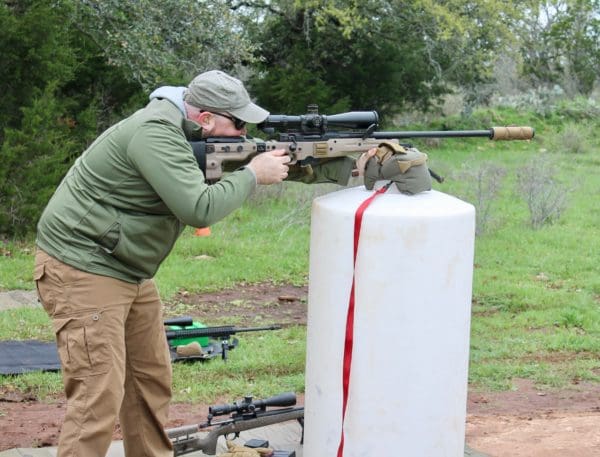
One of the nastiest problems he presented us with was this plastic barrel. We could use any number of bags, bipods, or buddies, but we had to shoot off the barrel. It gave me absolute hell but I finally got dialed in and started making hits at the quarter mile line on a barrel that refused to sit still. It was an intense exercise in focus, breathing, and trigger control – and one I never would have had the opportunity to try out otherwise.
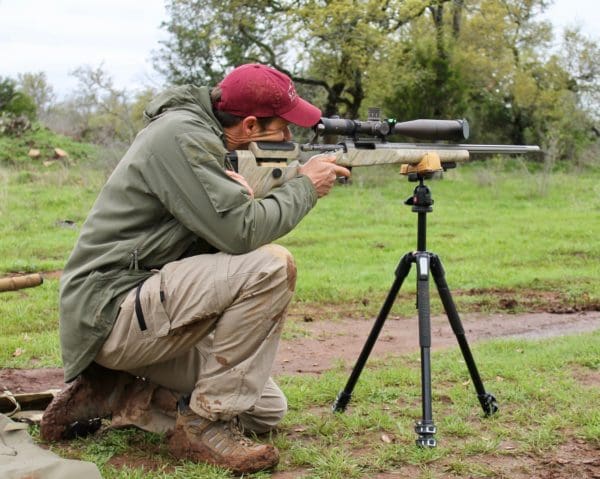
We retired to the classroom for another catered lunch to discuss more “buttonology” and that led to a free form discussion on ballistic solvers and the practical side of shooting. Very apparent to me was that Clayton is happiest on the range (who isn’t?), but he’s an excellent classroom instructor.
At one point, he discussed the skills required to hit an elk at 600 yards – accurately calling the wind, ranging the target, understanding the lay of the land – all the cool stuff. But then pointed out that if the elk is bedded down, there’s plenty of daylight left, and your shot is 600 yards with a full value crosswind why take that shot when an hourlong hike could get you a few hundred yards closer and put you out of the wind, facing directly at your trophy – why wouldn’t you hike a bit to ensure that your hit probability went up? Throughout the weekend, Clayton repeatedly emphasized that having the skill is awesome, but being able to think your way into a more successful shooting situation is much more important.
After waxing poetic, we left the classroom and headed back to the range to do a bit more shooting and then wrapped up our weekend with some final shots on the mover, and a free form session to let the students use the range to their liking. We finished up the day in the classroom where Clayton handed out his contact info, our certificates for completing the course, and his honest request for feedback. I took him at his word and penned a missive on Monday morning to discuss my initial feedback while things were fresh. With time on my side, I’ve edited them down to a few categories.
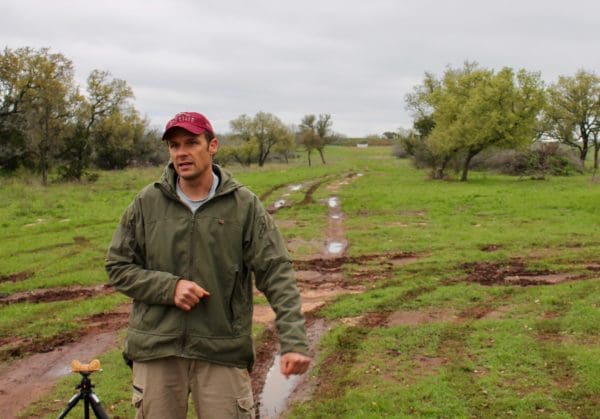
The Good
Clayton is clearly an expert when it comes to shooting a rifle. We’ve never hunted together, and he never fired a single round in class, but I wouldn’t hesitate to invite him out to the ranch to hunt this fall. I expect that anything he deemed worthy of killing would be ethically harvested. He knows his way around a rifle and that’s apparent at every avenue.
Beyond that, Clayton did a really good job of establishing a foundation by showing every student how to fit the rifle to their body, and properly set up a shot. He forced us to think about the myriad of variables that go into shooting a rifle at distance. Along the way, he gently coaxed the students into a proper shooting positions that would provide more stability and up the hit percentage.
Further, Clayton did a really job of explaining the importance of gathered data to be used at a later date. This was the first time that anybody has ever walked me through the process of collecting data, and then using it at a later date to build accurate range cards. I went shooting the weekend after class, and constantly referred to my known “good” data from class for my shots at various ranges. Given that, I bought a boatload of office supplies so I could build notebooks for all my rifles.
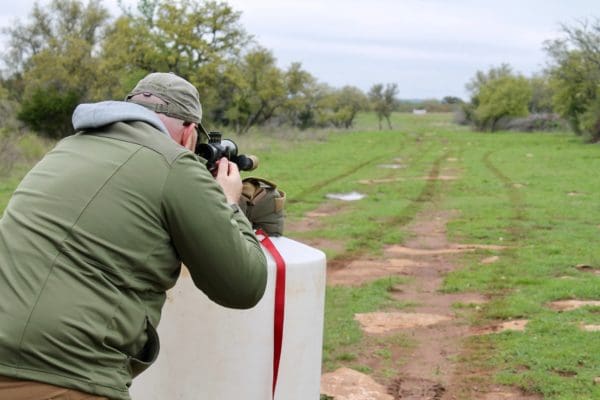
I went into this class with the expectation that I would learn how to control my body in such a way as to become a better shooter. I did not expect that I would work on my brain as much, but I found that Clayton’s constant urging to consider skills vs. tactics incredibly helpful. At one point during a discussion of shooting moving targets, he said, “Hey you should develop this skill because if you ever need it, you’ll really need it, but you should avoid having to take this shot at all costs.”
Last, I can’t say enough good things about the facility at Reveille Peak Ranch. There are very few places where you can be in an air conditioned classroom one minute and on a covered 100 yard range the next. A short walk away, and you can shoot reactive targets out to 700 yards, and a little drive gets you out to almost 900 with a really nice mover. To be quite honest, I would have paid $250 per day to have Clayton sit there quietly while I shot up a lot of Robert’s ammo.
All in all, Clayton did a great job of keeping the class size small enough to receive true one on one attention while also tailoring it to the various shooter types represented in class. I feel that the hunters, enthusiasts, and competitors in class got something out of the class that was specific to what they like to do.
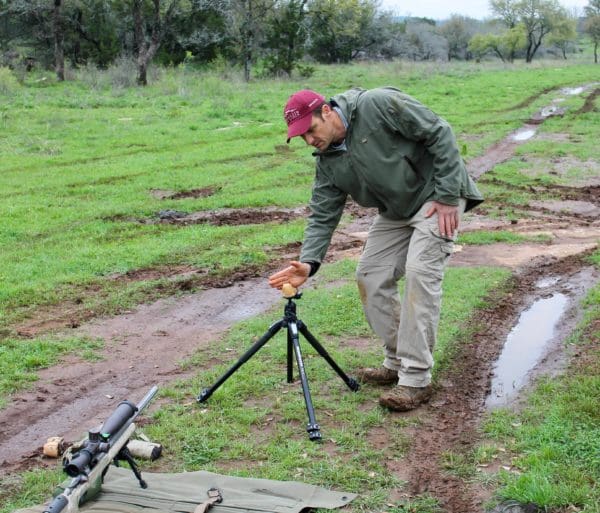
Room for Improvement
As this class is still fairly new, the structure and syllabus is still evolving. At times, I felt like we were burning up ammo at the range with no clear goal in sight. To be fair, the range is awesome, and burning up ammo is still fun, but there were some moments where I just stopped shooting and ran the spotting scope for other students.
In that vein, I would have been just as happy to have shot only a few round on the first day while working fundamentals out of the classroom range area. A lot of the form and fitment work we did at longer ranges could just as easily been worked out of the classroom, and I think the shorter distances on paper would have given the class a much better feel for the impact that those changes had on downrange accuracy.
The unfortunate reality is that a miss at 600 yards could be chalked up to so many things that it becomes a fool’s errand to try and narrow it down to one specific item. Removing the environment and distance might have helped with that.
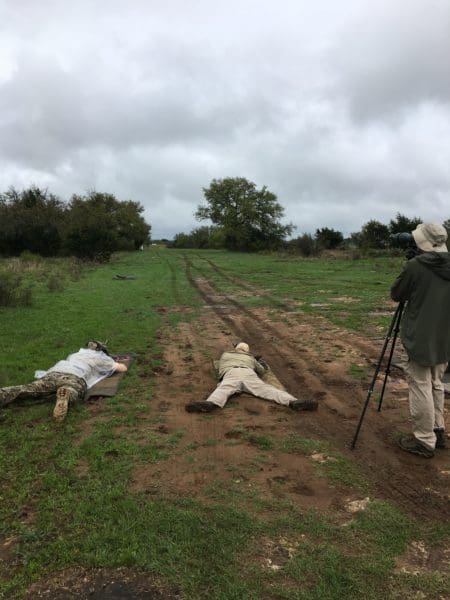
The portion of class that focused on logbook management was something I got A LOT out of, but didn’t really come into play until the middle of day two. It would have been better for me to get that data logging started early on day one so that I had a solid foundation for the longer range work on day two.
Probably the broadest critique I have of the class, and one that Clayton responded to directly was my perception that he didn’t “push” an agenda. At various points, I felt like he’d creep up on saying, “This is how this next thing should be done” but would then couch the statement with something along the lines of, “But there’s a lot of ways to accomplish this, so go with what works for you.”
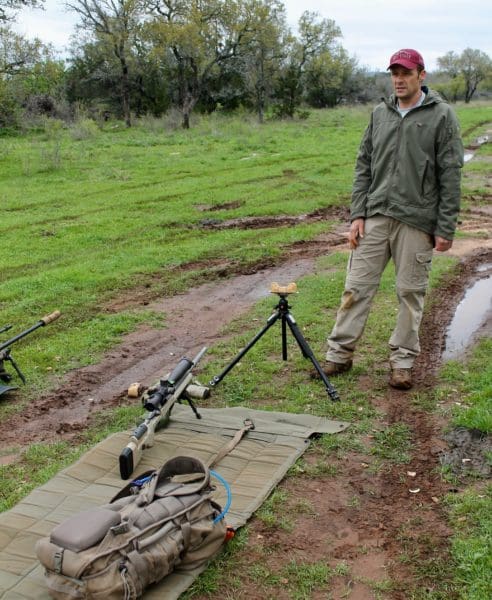
The truth of the matter is that Clayton has more experience behind the rifle than most recreational shooters will amass in a lifetime. While people might always do things differently, his opinion matters very much as it is rooted in, and built out of, real world experience.
Several times, I got the feeling that he was hesitant to correct a position, step in, have an opinion, or push an agenda. I’m leery of encouraging anyone to take a hard stand as there are numerous examples of inexperienced instructors leaving deep training scars on students, but I feel that given Clayton’s experience as a soldier and instructor, his way of doing things should probably be considered gold until otherwise proven wrong.

Rating (out of five stars):
Overall * * * *
Altogether, I fired exactly 200 rounds of ammo during the weekend, 153 rounds through my 6.5 Creedmoor rifle, and 47 through my .308 Win. A lot of them met dirt, but a more than a few met steel. I learned quite a bit about the physical and mental aspects of shooting a rifle at ranges from 100 to 800 yards and had a good time doing it. At $550 for a two day class, the price is in line with what is customary for expert instruction and range access, not to mention the fantastic classroom and target opportunities. The syllabus is still developing and I anticipate that this class will only get better with repetition. I hope to get back out next year to take it again to see what’s changed.




Did Clayton explain both the pros and the cons of that prone shooting position versus the more traditional prone shooting positions?
We talked a lot about squaring the body behind the rifle so that recoil impulse is driven backwards with no deviation. So, yes?
Sounds like class I desperately need to take. I may soon be giving him a call.
Glad you had fun and gained some experience. I’ve been shooting rifles seriously for over 40 years, but still learned a lot from two-day clinics taught by an Army sniper instructor at the Boomershoot event each year in Idaho. There’s truly a lot to learn about long range shooting, with much of it focused on getting a stable position and not rushing the shot.
I’m a bit curious about the prone position shown in your photos. Is that something new? I was taught, from multiple instructors, to keep the rifle, torso and dominant side leg all lined up, with the other leg angled out for stability. Having everything lined up provides (allegedly) better resistance to the position moving under recoil.
Same here on the torso alignment. My long-range course was also completed in a downpour. If it ain’t raining, you ain’t training!
The main points are natural point of aim and a symmetrical energy transfer of the recoil impulse. When you have an imbalance in position or muscle tension, then there is error in the shot before it leaves the barrel. If you can achieve those two concepts with those prone styles you mention, then keep them. However, they can be the cause of those errors in shooters. There are still applications for those prone styles and I am certainly not saying they are obsolete.
The discussion is probably too big for a comment reply space–I would say come check out the course! 😉
I learned a lot and re-learned a lot from Clayton’s class.
That was one heck of a fun weekend. As we progressed, I re-remembered so many things.
Body position behind the rifle. Cheek weld being consistent. Not using the right hand for a torque wrench.
I will be much more confident hunting this year.
If any of our readers want a really good long range precision rifle class, this is a great one.
Banging a 6 inch moving plate at 800 yards was a hoot. Great confidence builder!
Oh, and you guys complaining about 50 degrees and rain? That’s a pleasant day here in Oregon! Heck, that’s normal shoorting weather!
Great post! Just a couple things, here. I’m not a hunter, but it seems to me that, for a hunter, there would be at least some coverage for shooting uphill and downhill, but I never see such. In the long range class I took years ago, there were people who refused to believe that shooting either up- or down-hill would cause your shots to print high, actually seemed to want to argue with the instructor (Mid Thompkins), who had won so many national and international championships you couldn’t count them. A discussion of the amount of correction involved would seem nearly necessary, to me.
Then, having little to do with this particular post except an attempt to gain from your experience, I’d like to hear just how much point of aim adjustment you found when attaching/removing the can, and how consistent it was, particularly at longer ranges, since I rarely get the chance to swap back and forth at much more than 100 yards. Pretty please? I use my can on several calibers, but the only one that really concerns me is .308.
A lot of POI shift is dependent on barrel length and taper. For the guns in question, my TBAC Ultra 7 on my heavy profile 308 is wroth -.1 mil and my Sandman S on my lightweight profile 6.5 CM is -.6 mils. Both are very repeatable POI shifts.